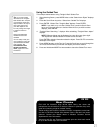
26
WARNING!
Never use
your ETX
Telescope to
look at the Sun! Looking
at or near the Sun will
cause instant and
irreversible damage to
your eye. Eye damage is
often painless, so there is
no warning to the
observer that damage has
occurred until it is too
late. Do not point the
telescope or its viewfinder
at or near the Sun. Do not
look through the telescope
or its viewfinder as it is
moving.
Children should
always have adult
supervision while
observing.
IMPORTANT NOTE FOR ALL ALIGNMENT-BASED OPERATIONS:
Only use the Arrow keys to move the telescope during the Identify
procedure. Do not loosen the telescope locks or move the base or the
alignment will be lost.
1. When a desired object is visible in the eyepiece, keep pressing MODE until the
“Select Item: Object” menu is displayed. Press ENTER to select this menu.
2. Scroll through the Object menu options until the “Object: Identify” screen appears.
3. Press ENTER. Autostar searches the database for the identity of the object being
observed.
4. If the telescope is not directly on an Autostar database object, the nearest
database object is located and displayed on the screen. Press GO TO and the
telescope slews to that object.
Browse allows you to search the database for objects with certain parameters, much
like a search engine. "Edit Parameters" lets you set various parameters for the search,
such as: Object Type, Minimum Elevation, Largest, etc. Once you have set the
parameters of the search, select "Start Search" and press ENTER. Autostar will
display the results of the search. See page 39 for more information.
Event Menu
The Event menu provides access to dates and times of astronomical events. The
Event database includes:
Sunrise and Sunset calculates the time that the Sun rises or sets on the current date.
Find rise and set times for other dates by entering a new date into the “Setup: Date”
menu. See
DATE, page 28 and also see ETX TIPS, page 23.
Moonrise and Moonset calculates the time that the Moon rises or sets on the current
date. Find rise and set times for other dates by entering a new date into the “Setup:
Date” menu. See
DATE, page 28 and also see ETX TIPS, page 23.
Moon Phases displays the date and time of the next Full, New, 1st Quarter and 3rd
Quarter Moon.
Meteor Showers provides information
on upcoming meteor showers, such as the
Perseids, the Leonids, etc. Also lists the dates of the showers and when they reach
maximum.
NOTE: Meteors are fast moving objects that cover large areas of the sky
and are usually best observed with the naked eye.
Solar Eclipse lists upcoming Solar Eclipses, including the date and type (total,
annular or partial) of eclipse and the location and time of the first and last contacts of
the Moon's shadow. Use the Scroll Up and Down keys to display the available data.
Remember, never use a telescope to look at the Sun! See
WARNING! to the left.
Lunar Eclipse lists upcoming Lunar Eclipses, including the date and type (total,
partial, penumbral) of eclipse. Use the Scroll Up and Down keys to display the
available data.
Min. (Minimum) of Algol is the minimum brightness of the dramatic eclipsing binary
star system, Algol. It is relatively close at a distance of 100 light years. Every 2.8 days
during a 10-hour period, Algol undergoes a major change in apparent magnitude as
one of the two stars passes behind the other. The combined magnitude of the two
stars thus dips from +2.1 to a minimum of +3.4 halfway through the eclipse as the
second star is hidden. Autostar calculates minimum magnitude time at mid-eclipse.
Autumn and Vernal Equinox calculates the time and date of the fall or spring
equinox of the current year.
Winter and Summer Solstice calculates the time and date of the winter or summer
solstice of the current year.
Glossary Menu
The Glossary menu provides an alphabetical listing of definitions and descriptions for
common astronomical terms and Autostar functions. Access directly through the
Use the Event menu
to look up dates of various
astronomical events, such
as sunrises and sunsets,
eclipses, moon phases,
meteor showers, equinoxes
and solstices...
...and not just for the
current date. Set any date,
past or future, when
initializing Autostar and you
can check the time for
other events.
Use the Glossary menu
to look up definitions of
astronomical terms and get
a description of Autostar
features.
Want to learn more about
using the Browse menu?
See page 39.


















